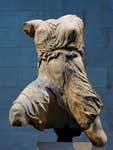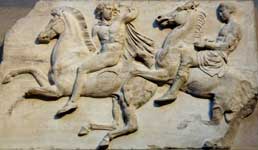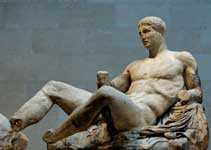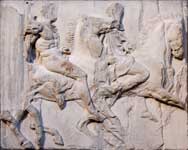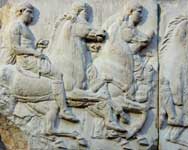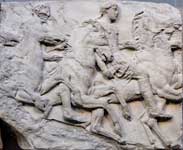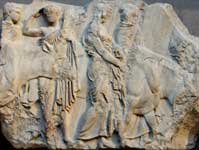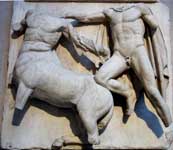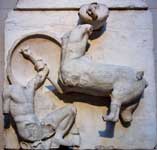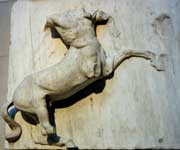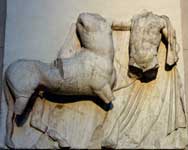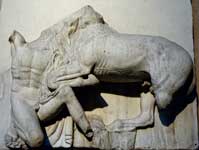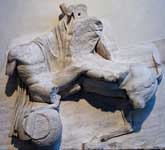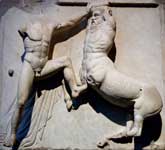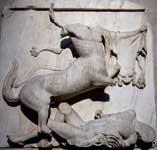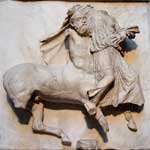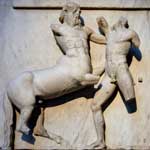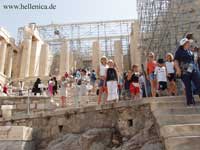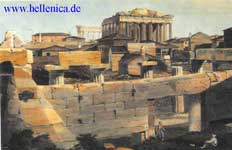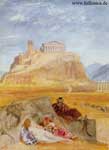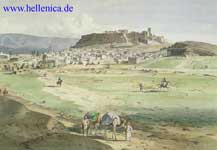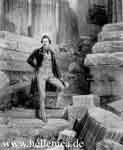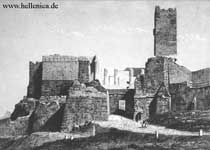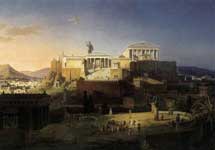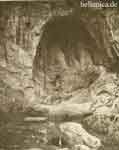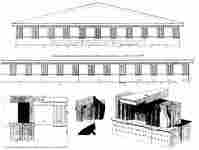.
Griechenland: Der Parthenon auf der Akropolis
Part 2
Blind are the eyes that do not shed tears while seeing, O Greece beloved, your sacred objects plundered by profane English hands that have again wounded your aching bosom and snatched your gods… Lord Byron, Childe Harold, about the Elgin Marbles ironically the same Lord Byron, the romantic Philhellene, who left 1810 a Graffiti on the South colonnade of the Poseidon Temple at Sounion , like some ancient Greeks soldiers did in Egyptian temples (a white wall is the fool's paper).
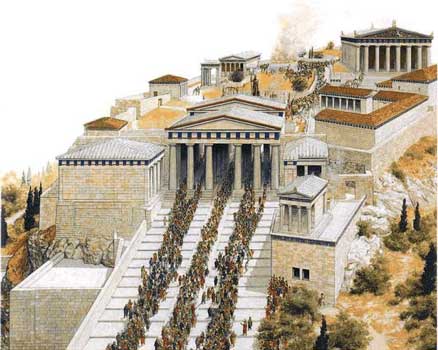
The Panathenaia festival
The Panathenaia represented by Pheidias on the Parthenon frieze was the most important Athenian festival celebrated every four years in the month of Hekatombaion (July-August) in honor of the goddess Athena. The festival was established in prehistoric times (according to the myth by Erichthonios and later reorganized by Theseus). The tyrant Peisistratos (566 BC) modified it again to The Great Panathenaia so that in the period from the 6th to the 4th century BC it become a Panhellenic festival. The Lesser Panathenaia was held annually locally. The festival included athletic and music contests which lasted up to 12 days. The festival reached its peak at the birthday of Athena (28th Hektatocombaion). Up to 100 bulls were sacrificed (Hekatocomb). A peplos (a dress) was woven with thread of gold by the Arrephoroi and the Ergastinai, maidens from prominent families. In a procession from the Kerameikos to the Acropolis it was carried like a sail on a wheeled ship as far as the Eleusinion and thereafter by hand. On the Acropolis the peplos was handed over to priests, who dressed the xoanon (the venerable wooden statue) of the goddess, initially in the archaios naos (most ancient temple), later in the Erechtheion (Athena was the inventor and patron of working in wool). Around 250 animal sculptures (mainly horses) and 360 human figures were shown in the Parthenon.
Athena Parthenos in the Parthenon and Athena Promachos

Like in many Greek sculptures, also for the Parthenon color was used as decoration, as shown in the above reconstruction of the southwest corner with metopes; Attributed to Phidias: Centaur choking Lapith (The blue parts are Triglyphs)
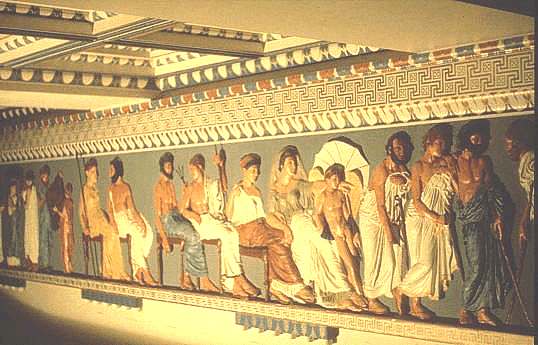
and in this frieze reconstruction (an unusual view since we are used to see the marble with the color lost after almost 2500 years).
A British ambassador at Constantinople , Thomas Bruce, the 7th Earl of Elgin, removed one caryatid from the Erechtheion and approximately half of all surviving sculptures from the Parthenon, with the permission of the Sultan (who probably was not very intelligent!). These so called Elgin Marbles are now in the British Museum in London (Earl of Elgin sold them to the British government for 35000 £) while other parts are in the Louvre, Paris, and in other places. Interesting is that the British Museum officials asked Melina Merkouri around 30000 £ for a copy of an element of the Erechtheum, almost the same amount given to Elgin for all the Acropolis marbles.
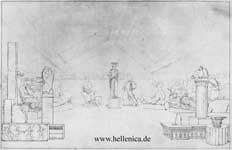
Elgin Marbles, Lord Elgin Museum , Park Lane
|
|
|
|
|
|
|
|
|
|
|
|
|
|
||
|
|
|
|
|
|
|
|
|
|
|
|
|
|
|
|
|
|
|
|
|
|
Picture Galleries of the "Elgin" Marbles
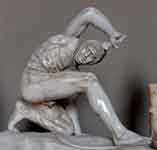
Persian Soldier, Vatican 2794, dedication by the Attalids (probably Attalus II), copy

dedication of the Attalids on the Acropolis (part of a group with sculptures from an Amazonomachy, war with the Persians, Gauls and Gigantomachy)

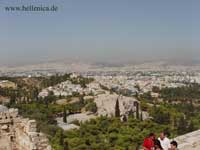 |
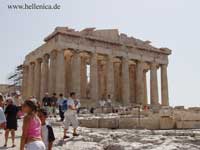 |
|
 |
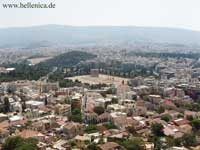 |
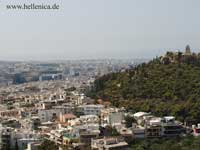 |
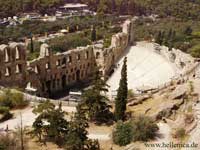 |
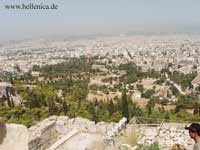 |
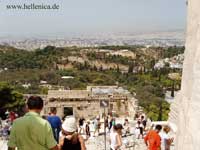 |
 |
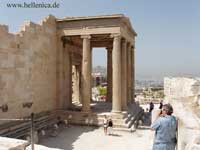 |
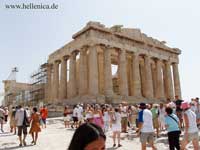 |
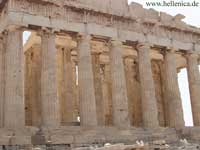 |
Klick images to enlarge
All Photos (C) Evangelos Mantadaki
The Erechtheion and the punishment of the Caryatides
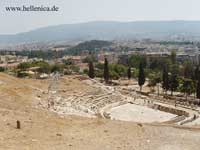
Dionysos Theater, Athens Greece

Remarks
The history of different versions and plans of the Parthenon (Parthenon I, Parthenon II and Parthenon III, etc) is too complicated and more interesting for “Pathenonologists”.
Pericles' general manager and overseer was Pheidias, though the several works had great architects and artists besides. The Parthenon, for instance, . . . was built by Kallikrates and Iktinos . . . but it was Pheidias who produced the great golden image of the goddess . . . . Almost everything was under his supervision, and he was overseer of all the other artists, owing to his friendship with Pericles. This brought every envy upon the one and slander against the other, to the effect that Pheidias was in the habit of procuring free-born women for Pericles when they came to see the building site The comic poets took up this story and began a smear campaign. . . . But the worst charge of all, and yet the one best supported by the evidence, was the following: Pheidias the sculptor was contractor for the great statue, as I have said, and being a friend of Pericles and having great influence with him, made on that account a number of jealous enemies. Others, too, decided to use him to test the people, in order to see what the popular judgment would be in a case involving Pericles. They therefore persuaded one Menon, an assistant of Pheidias, to sit in the agora as a suppliant and to ask for immunity in return for laying information and bringing a charge against Pheidias. The demos granted the man's plea, and a motion to prosecute was laid before the Assembly. Yet the charge of theft was not proven, because right from the very beginning, at Pericles' suggestion, the gold had been worked and fitted to the statue in such a way that it could all be taken off and weighed, and this was now what Pericles ordered the prosecutors to do. But the fame of his works still aroused jealousy against Pheidias, especially since when he made the Amazonmachy on the shield he included both his own portrait among the reliefs, as a bald old man lifting a stone high with both hands, and a very handsome one of Pericles fighting an Amazon. And the position of Pericles' arm, which is holding a spear before his eyes, is cunningly contrived for the purpose of concealing the likeness--which is, however, perfectly plain from either side. So Pheidias was led away to prison and there fell sick and died; some even say he was poisoned by Pericles' enemies in order to blacken Pericles still further. And as for the informer, Menon, a proposal was passed, on a motion of Glykon, to grant him immunity, and the generals were instructed to provide for his safety. . . . but the truth [concerning all this] is not clear...
When the orators, who sided with Thucydides and his party, were at one time crying out, as their custom was, against Pericles, as one who squandered away the public money, and made havoc of the state revenues, he rose in the open assembly and put the question to the people, whether they thought that he had laid out much; and they saying, "Too much, a great deal," Then," said he, "since it is so, let the cost not go to your account, but to mine; and let the inscription upon the buildings stand in my name." When they heard him say thus, whether it were out of a surprise to see the greatness of his spirit or out of emulation of the glory of the works, they cried aloud, bidding him to spend on, and lay out what he thought fit from the public purse, and to spare no cost, till all were finished. Plutarch, Pericles
Parthenon’s conversion to a Christian church had serious negative effects; many of the metopes on the west, east and north sides were chiseled off. In addition, the bigger pediment statues, located in the middle of the east pediment, were taken down and 6 Blocks of the frieze were removed to create windows. Also an apse was added, new entrances on the west side were opened, and a staircase was placed in the NW corner of the cella. The Christian Parthenon is dedicated to St. Sophia and later to Virgin Mary, for many centuries, its common name is “Our Lady of Athens”.
( http://www.london2athens.com/ )
|
|
|
|
|
|
|
|
|
|
|
|


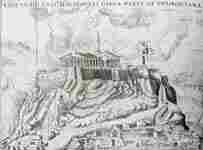
Funny Stories
From Magnificent Parthenon :
The legend was kept, how an aged donkey carried each day rocks for the building of Parthenon on Acropolis. When the donkey aged it was freed from responsibilities. But each morning the aged donkey went with all to Parthenon. And the Greeks said: " Look, even the aged donkey understood a significance that we created". And the people gave him the "pension" by undertaking to feed it for the public score up to the death.
What do the Parthenon Marbles say in the British Museum!
The Parthenon Sculptures















The Parthenon Frieze : See the South Frieze , East Frieze , North Frieze , West Frieze
University of Southern California Virtual Reality Computer Reconstructions, Images and Videos
From the British Museum the “Elgin Marbles” Friezes , Pediments , Metopes , Panoramas
QUOTATIONS
The extreme definiteness with which they stand, now a brilliant white, again yellow, and in some lights red, imposes ideas of durability, of the emergence through the earth of some spiritual energy elsewhere dissipated in elegant trifles. But this durability exists quite independently of our admiration. Although the beauty is sufficiently humane to weaken us, to stir the deep deposit of mud--memories, abandonments, regrets, sentimental devotions--the Parthenon is separate from all that; and if you consider how it has stood out all night, for centuries, you begin to connect the blaze (at midday the glare is dazzling and the frieze almost invisible) with the idea that perhaps it is beauty alone that is immortal. Virginia Woolf, Jacob's Room
The only thing that I will sadly miss after my death is that I will not see anymore the Acropolis, Mikis Theodorakis who has a house close to the Acropolis according to Eberhard Schade from the German Newspaper Die Zeit (2002-07-18).
So all this really does exist, just as we learnt at school! Siegmund Freud In the summer of 1904, after prolonged hesitation, Freud suddenly traveled to Athens in the company of his brother Alexander. Once up on the Acropolis, instead of the expected admiration, he was enveloped by a strange feeling of doubt. He was surprised that something he had been learning about at school really exists. He felt divided in two: one person who empirically realized his actual presence on the Acropolis and the other that found it hard to believe, as if denying the reality of the fact. A disturbance of memory on the Acropolis
The restoration (of the Parthenon), one of the greatest monuments of humanity, has been on for years and it is not yet close to completion. The archaeologists and architects in charge claim that the restoration will not be completed till 2030 or even 2050! Anistoriton Issue A974 of 9 Nov. 1997
While so many praise the Parthenon there are some with a different opinion
Der griechische Tempel ist eigentlich kein Gebäude, sondern ein Monolithendenkmal in der Art der Cromlechs. Deshalb ist auch seine Bedachung, insbesondere die Giebelgestaltung, eine primitive und schwache Lösung. Die obligatorische plastische Giebelfüllung mitsamt dem falschen Gebälk ist, architektonisch betrachtet, eine Monstrosität. Walther Rathenau (German Politician). My translation: The Greek temple is actually not a building, but a monolith monument in the kind of the Cromlechs (a neolithic group of stones consisting of one large flat stone supported by several vertical ones). Therefore also its roof covering, in particular the Pediments composition, is a primitive and weak solution. The mandatory plastic Pediment coverage with the wrong timber work is architecturally regarded, a monstrosity. http://www.walther-rathenau.de/kuenstler.htm
The Parthenon is really only a farmyard over which someone put a roof; colonades and sculptures were added because there were people in Athens who happened to be working and wanted to express themselves. It is not what the artist does that counts, but what he is. Pablo Picasso
The Greek Temple and the Doric, Ionic and Corinthian Orders
Old and Historic Images
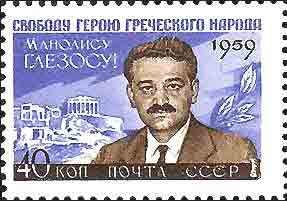
The Greeks Manolis Glezos (on a stamp from the Soviet Union) who on the night of May 30th 1941 and Apostolis Santas tore down the Nazi flag on the Acropolis
WWII : German Occupation forces on the Acropolis (Erechtheion) , A dark moment: German Flag on the Acropolis :
Jacqueline Kennedy with the wife of Konstantinos Karamanlis at the Parthenon, 11 June 1961
Constantine Mitsotakis and George Bush at the Parthenon (a hot summer day)
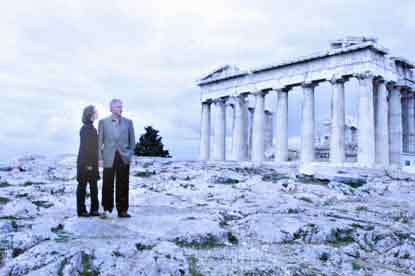
Former US President B.Clinton and his daughter Chelsea on the Acropolis (Source)
Parthenon "Copies"
The "Walhalla" Parthenon 1842 Germany
Image, Stern Journal 1998 Nr 39, Germany
German
Eine Rekonstruktion der Propyläen nach Bauteilen
Virtueller Gang durch die klassische Akropolis von Athen
Lambert Schneider, Christoph Höcker, Die Akropolis von Athen , Eine Kunst- und Kulturgeschichte, Primus-Verl., Darmstadt 2001
References
Melissa Books 1) THE PARTHENON and Its Impact in Modern Times, 2) The Stones of Parthenon 3) Manolis Korres From Pentelicon to the Parthenon
Jr., Robert Bowie Johnson, The Parthenon Code: Mankind's History in Marble , Solving Light Books (June, 2004) ISBN: 0970543832 (A "Christian" interpretation of the "Pagan" Parthenon sculptures)
| Ancient Greece
Science, Technology , Medicine , Warfare, , Biographies , Life , Cities/Places/Maps , Arts , Literature , Philosophy ,Olympics, Mythology , History , Images Medieval Greece / Byzantine Empire Science, Technology, Arts, , Warfare , Literature, Biographies, Icons, History Modern Greece Cities, Islands, Regions, Fauna/Flora ,Biographies , History , Warfare, Science/Technology, Literature, Music , Arts , Film/Actors , Sport , Fashion --- |

